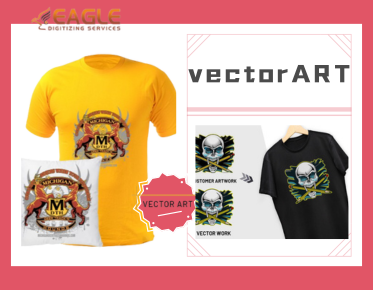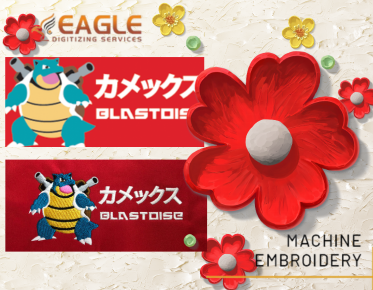Nail Your First Embroidery: Projects and Tips for Beginners
Embroidery is a timeless craft that invites creativity and patience. It's more than just stitching; it's an art form that lets you express yourself through thread and needle. Whether you're looking to create a personal keepsake or a unique gift, embroidery offers endless possibilities for exploration and satisfaction. It’s a craft that welcomes everyone, regardless of skill level, and is a fantastic way to unwind while crafting something beautiful. If this post spurred your interest and you want to find out more about Embroidery Digitizing, please feel free to contact us.
Why Starting with Simple Projects Can Spark Your Creativity
Starting with simple embroidery projects can be incredibly rewarding. These beginner-friendly projects not only build your confidence but also spark your creativity. They provide a solid foundation in basic techniques, allowing you to gradually experiment with more complex designs. The success of these initial projects can fuel your passion for embroidery and inspire you to tackle more ambitious pieces.
Project 1: Simple Monogrammed Towels
Materials You’ll Need for Monogramming
To create monogrammed towels, you’ll need a towel, embroidery floss, an embroidery hoop, and a needle. Choose a color of thread that contrasts well with the towel to make your monogram stand out. You might also need a fabric stabilizer if your towel is particularly fluffy, to keep the fabric smooth while stitching.
Step-by-Step Instructions to Create Your Monogram
1. Prepare Your Towel: Wash and iron your towel to ensure it's clean and smooth.
2. Transfer the Design: Use a fabric marker to lightly trace your monogram onto the towel.
3. Hoop the Fabric: Place the towel in the embroidery hoop and tighten it to keep the fabric taut.
4. Stitch: Begin stitching your monogram using a backstitch or satin stitch for a clean, polished look.
5. Finish: Once completed, remove the towel from the hoop and gently wash away any marker lines.
Tips for Perfecting Your Lettering Technique
Practice makes perfect when it comes to monogramming. Start with simple, block letters before moving on to more intricate fonts. Keep your stitches even and consistent to ensure your monogram looks professional. Use a stabilizer if your fabric is too soft or thick.
Project 2: Cute Embroidered Patches
How to Design Your Own Embroidered Patch
Designing an embroidered patch involves creating a simple, bold design that works well on a variety of fabrics. Start with a small sketch and choose a limited color palette to ensure your design is clear and effective. Use embroidery software or tracing paper to finalize your design before transferring it to fabric.
Choosing the Right Stitch Techniques for Patches
For patches, the satin stitch is ideal for smooth, solid areas, while the split stitch can add texture and detail. Ensure your stitches are tight and well-aligned to avoid fraying edges. Use a stabilizer behind the fabric to maintain its shape and prevent distortion.
Attaching Your Patch to Different Fabrics
Patches can be sewn or ironed onto fabrics. To sew on a patch, use a matching thread and a simple running stitch around the edges. To achieve a solid bond, follow the manufacturer's directions when applying iron-on patches. Test the adhesive on a scrap piece of fabric first to prevent damage.
Project 3: Floral Embroidery on Canvas Bags
Selecting the Right Bag and Threads
Canvas bags are a sturdy choice for embroidery and provide a great surface for floral designs. Choose a bag with a tight weave to hold your stitches securely. For threads, opt for colorful embroidery floss that contrasts well with the bag’s color, adding vibrancy to your floral patterns.
Basic Floral Stitches to Get You Started
Begin with simple stitches like the French knot for flower centers, and the lazy daisy stitch for petals. The stem stitch works well for leaves and stems. Combining these basic stitches can help you create a beautiful, cohesive floral design.
Adding Personal Touches with Colors and Patterns
Experiment with different thread colors and patterns to add a unique touch to your bag. Consider using variegated threads for a multi-toned effect or adding embellishments like beads for extra flair. Personalizing your design with initials or small motifs can make your bag truly one-of-a-kind.
Project 4: Embroidered Keychains
Materials Needed for Your Keychain Project
For embroidered keychains, you'll need fabric, embroidery thread, keychain rings, and a small piece of interfacing to stabilize the fabric. Choose a sturdy fabric that can withstand daily use, and select threads in your favorite colors for a personalized touch.
Tips for Small-Scale Embroidery
Small-scale embroidery requires precision. Use a small needle and fine thread to maintain detail in your design. It’s helpful to work with a smaller embroidery hoop or even a hoopless technique for better control. Plan your design carefully to ensure it fits well within the keychain size.
Ideas for Unique Designs and Shapes
Consider simple, recognizable shapes like hearts, stars, or initials for your keychains. You can also create mini designs that reflect personal interests or hobbies. Adding a small, unique touch like a tiny charm or bead can enhance the charm of your keychain.
Project 5: Personalized Pillow Covers
Choosing Fabrics That Work Well for Pillows
For pillow covers, select fabrics that are both durable and easy to embroider, such as cotton or linen. These fabrics hold stitches well and maintain their shape over time. Choose a fabric that complements your home decor and provides a good surface for your design.
Step-by-Step Guide to Designing Your Pillow Cover
1. Prepare the Fabric: Wash and iron your fabric before starting.
2. Transfer the Design: Use a fabric marker to outline your design on the fabric.
3. Stitch: Use your chosen embroidery stitches to fill in the design.
4. Assemble the Pillow: Sew the embroidered fabric pieces together, and insert a pillow form.
Tips for Finishing Edges and Making It Durable
To ensure your pillow cover lasts, finish the edges with a serger or a zigzag stitch to prevent fraying. Iron the cover after sewing to smooth out any wrinkles and give it a crisp look. Consider adding a zipper or button closure for easy removal and cleaning.
Project 6: Simple Wall Art
How to Choose Your Design and Fabric
Select a design that suits the wall space and complements your decor. For fabric, use a canvas or cotton that is easy to stretch and frame. Choose a design that is simple yet striking, as it will be displayed prominently.
Techniques for Framing Your Embroidery
To frame your embroidery, stretch the fabric over a canvas or wooden frame and secure it with staples. Alternatively, you can use an embroidery hoop as a simple and stylish frame. Ensure the fabric is taut and smooth for a polished finish.
Displaying Your Work: From Wall Hangings to Gallery Walls
Hang your framed embroidery in a place where it can be appreciated. For a gallery wall, arrange multiple pieces in a cohesive layout. Use matching frames or mats to create a unified look, and consider varying sizes and orientations for visual interest.
Project 7: Embroidered Bookmarks
Selecting the Best Fabrics for Bookmarks
Choose a fabric that is both durable and easy to handle, such as felt or sturdy cotton. These fabrics hold up well to frequent use and provide a nice texture for embroidery. Consider using interfacing to add stiffness if needed.
Easy Stitch Techniques for Beautiful Designs
For bookmarks, simple stitches like the satin stitch or backstitch work well. You can also use decorative stitches to add flair. Embroider a small design or monogram to personalize the bookmark and make it special.
Personalizing Your Bookmark for Gifts
Add a personal touch by incorporating the recipient’s name or favorite colors. Consider embellishing with small charms or tassels for added elegance. Personalized bookmarks make thoughtful gifts for readers and book lovers.
Project 8: Fun Embroidered Coasters
Materials for Durable and Attractive Coasters
For coasters, use fabric that is durable and easy to clean, such as cotton or a cotton blend. To make them sturdy, add a layer of felt or interfacing between the fabric layers. This will help the coasters retain their shape and provide additional protection for surfaces.
Step-by-Step Instructions for Your Embroidery Design
1. Cut the Fabric: Cut your fabric into coaster-sized circles or squares.
2. Transfer the Design: Use a fabric marker to outline your design.
3. Stitch: Embroider your design using your chosen stitches.
4. Finish: Attach a backing fabric for added durability and to complete the coaster.
Tips for Sealing and Protecting Your Coasters
To protect your embroidered coasters, consider applying a clear fabric sealant or spray. This will help resist stains and spills. Regularly clean your coasters by wiping them with a damp cloth to keep them looking fresh.
Tips and Tricks for Beginner Embroiderers
Mastering Basic Stitches: A Quick Guide
Start by mastering a few basic stitches like the running stitch, backstitch, and satin stitch. These stitches form the foundation of many embroidery designs. Practice these stitches on scrap fabric until you feel comfortable and consistent.
How to Keep Your Thread Organized
Keep your thread organized by using bobbin boxes or thread racks. Labeling each color can also save time and prevent confusion. Additionally, store your threads in a cool, dry place to avoid tangling and deterioration.
Avoiding Common Mistakes: Lessons Learned
Common mistakes include uneven stitching, fabric puckering, and incorrect tension. To avoid these issues, regularly check your stitching and fabric tension. Practice on scrap fabric and review your techniques to continually improve.
The Importance of Practice
Why Repetition Helps Improve Your Skills
Repetition is key to improving your embroidery skills. The more you practice, the more comfortable you’ll become with different stitches and techniques. Regular practice helps refine your skills and boosts your confidence in tackling more complex projects.
Setting Aside Time for Regular Practice Sessions
Set aside dedicated time for embroidery practice to develop a consistent routine. Whether it’s a few minutes each day or a couple of hours each week, regular practice will accelerate your learning and enhance your skill set.
Keeping a Journal of Your Progress
Maintain a journal to document your projects, techniques learned, and any challenges faced. This can be a valuable resource for tracking your progress and reflecting on your growth. Include photos of your work and notes on what you’ve learned.
Troubleshooting Common Embroidery Issues
Fixing Thread Tangles and Breaks
Thread tangles and breaks are common issues. To fix them, ensure your thread is properly threaded and that the tension is correctly set. If tangling persists, consider using a higher-quality thread or adjusting the bobbin tension.
Dealing with Fabric Puckering: Prevention and Solutions
Fabric puckering can be caused by uneven tension or stitching too tightly. To prevent puckering, use an embroidery stabilizer and maintain even tension throughout your stitching. If puckering occurs, gently press the fabric with an iron to smooth it out.
How to Correct Mistakes Without Starting Over
If you make a mistake, don’t panic. Most errors can be fixed without starting over. Carefully remove the incorrect stitches using a seam ripper, and redo the section. Practice patience and precision to correct mistakes seamlessly.
Embroidery offers endless possibilities for creativity and personal expression. From simple beginner projects to complex designs, your journey is unique and full of potential. Keep exploring new embroidery projects to continue growing and discovering new techniques. Challenge yourself with different materials and designs to keep your craft exciting and fresh. The world of embroidery is vast, and there’s always something new to learn.
.png)


